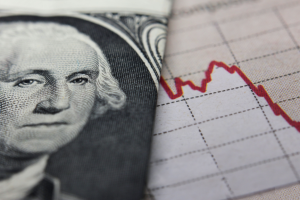A lot of once high-flying growth stocks have fallen on hard times. Many of the companies that thrived during the pandemic have been left out of the current market recovery and look unlikely to regain their former glory. A lot of these stocks are tied to unprofitable start-ups or companies whose services worked well when we were sheltering in place at home. While some stocks go through difficult periods and manage to recover, this is not the case with every stock. Some securities never return to their former highs, including these seven growth stocks to avoid.
Growth Stocks to Avoid: Zoom Video (ZM)
Zoom Video (NASDAQ:ZM) took off like a rocket during the Covid-19 pandemic as work and school went remote. Between March and Oct. 2020, ZM gained 422%. Since then, the momentum is gone, with the stock collapsing 88%. Today, Zoom Video’s stock trades just 10% higher than its 2019 initial public offering.
The downturn can be blamed primarily on one thing: return to work and school. Demand for video conferences has fallen sharply now that the pandemic is behind us. Growth at Zoom Video has slowed considerably as a result. Quarterly revenue growth at the company has slowed from more than 300% during the pandemic to only 4.45% today. Not only is the return to work hurting ZM stock, but the company is facing growing competition in its core video conference business. Make no mistake, Zoom Video is one of the top failed growth stocks to avoid.
Growth Stocks to Avoid: Robinhood Markets (HOOD)
Since going public, Robinhood Markets (NASDAQ:HOOD) has crumbled 72%. The online trading platform just hasn’t been the same since the Covid-19 investing craze subsided and gave way to a bear market. The company, whose trading app has proven to be popular with retail investors, had seen its user base and earnings grow with the popularity of cryptocurrencies such as Bitcoin (BTC-USD). But here too, Robinhood has seen its business drop off.
Most recently, Robinhood was forced to end support for the cryptocurrencies singled out by the U.S. Securities and Exchange Commission (SEC) in its multiple lawsuits against several cryptocurrency exchanges. Investors using the Robinhood trading app and platform will no longer be able to buy and sell cryptocurrencies such as Cardano (ADA-USD), Polygon (MATIC-USD), and Solana (SOL-USD). This is just one more reason for users to move on from Robinhood Markets. This makes HOOD another one of the top growth stocks to avoid.
Growth Stocks to Avoid: FedEx (FDX)
Investors are throwing in the towel on FedEx (NYSE:FDX) after the shipping and logistics company’s latest earnings. The company reported a 28% decline in its earnings per share to $4.94 for its fiscal fourth quarter, as revenue declined 10.2% to $21.9 billion. Analysts polled by FactSet expected earnings of $4.85 a share on sales of $22.55 billion. Worse, full-year earnings at the company fell 27% from a year earlier to $14.96 per share while revenue decreased 3.5% to $90.2 billion.
For its 2024 fiscal year, FedEx guided for earnings of $16.50 to $18.50 a share on flat to low single-digit revenue growth. Analysts had expected fiscal 2024 earnings of $18.33 a share on $90.91 billion in sales. FedEx’s earnings have now declined an average of 27% during the last three consecutive quarters. The company also announced that Chief Financial Officer (CFO) Michael Lenz will retire on July 31 of this year. FDX stock is up a slight 2% over the last 12 months and has gained only 8% over the last five years, making it a failed growth stock.
Coinbase (COIN)
Cryptocurrency exchange Coinbase (NASDAQ:COIN) is having a rough go of it. The U.S. SEC launched a lawsuit against it, accusing the company of operating as an unregistered broker. In fact, the Wall Street regulator alleges that Coinbase’s main brokerage, exchange, and staking programs all violate American securities laws. They’re serious charges that have cast a cloud over COIN stock.
The company is defending itself against the SEC charges and is also having to fend off growing calls in Washington, D.C. to regulate it and other cryptocurrency exchanges. However, the lawsuit is just the latest problem Coinbase has faced. And while Coinbase has the financial resources to fight back against the SEC, there’s no guarantee the company will prevail in court. Although COIN stock has rallied this year, the share price is down 80% since the company went public in April 2021. This makes Coinbase a risky investment.
Alibaba (BABA)
A decade ago, Chinese tech giant Alibaba (NYSE:BABA) held the biggest initial public offering ever, raising $21.8 billion for the company and its investors. While many shareholders continue to hold onto BABA stock hoping for a resurgence, the reality is that the company and its shares have never lived up to the initial promise. Since its 2014 IPO, Alibaba’s stock is down 7%. Over the last year, the share price has fallen 25%. And the stock is down 53% through five years. By almost any metric, this has been a losing stock.
As a company, Alibaba has experienced almost constant turmoil over the past three years. After authorities in Beijing singled the company out for multiple punishments, including a landmark antitrust fine, news comes in recent months that Alibaba’s latest CEO, Daniel Zhang, has stepped down. The leadership change comes as China’s largest e-commerce company restructures into six separate business groups and prepares to spin off its cloud computing unit into a separate publicly traded company. Will it all work? Nothing else at the company has.
Block (SQ)
Shares of financial technology firm Block (NYSE:SQ) were struggling before this year as the company’s shift to focus on cryptocurrencies had led many investors to move away from the company. However, the stock really took a drubbing after notorious short seller Hindenburg Research published a scathing report alleging that the company falsely inflates its Cash App user numbers and takes a “Wild West” approach to compliance and internal controls.
SQ stock immediately fell 15% on news of the short seller report. Hindenburg’s report also claims that Block engages in “criminal activity” and that “fraud” is rampant on its platform. Of course, Block, formerly known as Square, issued a strong response to the Hindenburg report, saying it is considering legal action. But the short seller report seemed to be the latest body blow to a former growth stock that is against the ropes. Block’s stock is down 3% over the last 12 months and its five-year gain now stands at a tepid 4%.
Intel (INTC)
Intel (NASDAQ:INTC) is spending money at an alarming rate trying to reposition itself against Taiwan Semiconductor Manufacturing Co. (NYSE:TSM). Will the transition work? Maybe. But getting there is proving painful for INTC shareholders. Earlier in June, Intel’s stock fell 6% after the company issued an update on its transition plans and said it will change the way it reports financial results to give its foundry business its own profit-and-loss statement.
The corporate update came days after Intel announced it is spending $33 billion to build two new chip fabrication plants in Germany, the latest in several multi-billion dollar investments around the world. German Chancellor Olaf Scholz called the two new plants the largest foreign investment in Germany’s history. That’s great news for the German economy, but the spending has raised eyebrows on Wall Street, especially after Intel reported the biggest net loss in its history this May. INTC stock is down 31% in the last five years.
On the date of publication, Joel Baglole did not have (either directly or indirectly) any positions in the securities mentioned in this article. The opinions expressed in this article are those of the writer, subject to the InvestorPlace.com Publishing Guidelines.






